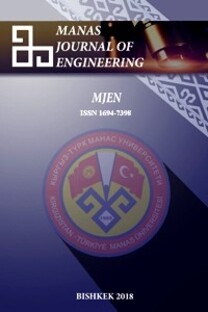Phenol recovery and removal from aqueous solutions by emulsion liquid membranes
Emulsion type liquid membrane process is a new and effective method for separation of mixtures with applications in the nuclear industry, hydrometallurgy and wastewater treatment. The emulsified liquid membrane is made by forming an emulsion of two immiscible phases and then dispersing the emulsion in a third phase (i.e. continuous or feed phase). Phenol is mainly found in the wastewaters of such industries as petroleum refineries and petrochemicals. In addition phenol is also contained in the wastewaters of industries of resins, explosives, paper, plastics, glass and rubbers. Numerous solvent extraction techniques using various ligands are also used as commercial in such processes as hydrometallurgy and wastewater treatment. However one of the disadvantage of solvent extraction is the necessity of solvents and ligands of large quantities. Water-oil-water (W/O/W) type of liquid membrane system provides excellent separation techniques and thus this causes a substantial reduction in the amount of ligands and solvents, Liquid membrane phase consist of a surfactant (Span 80) and solvent (kerosene). In this study the most important parameters that provide the extraction of phenol from aqueous solutions and their effect on extraction efficiency were examined by liquid membrane process. These parameters are determined to be as membrane viscosity, treatment ratio (feed volume/emulsion volume), surfactant concentration, feed concentration and pH, mixing speed and phase ratio (stripping solution volume / membrane volume). The phenol was extracted from the aqueous feed solutions in which phenol concentration ranged from 100 to 550 mg/L. Optimum parameters were found to be as: pH = 4; phase ratio, ϕ = 1; mixing speed (300 rpm); 3 % Span 80 and 2 % NaOH. Under the suitable conditions, about 96 % of the phenol in the feed solutions could be removed from the solution It has been possible that the phenol concentration were reduced from 550 mg/L to 5-10 mg/L within two minutes.
___
- 1. M.J. Gonzalez-Munoz, S. Luque, J.R. Alvares, J. Coca, Recovery of phenol from aqueous solutions using hollow fibre contactars, J. Memb. Sci. 213(2013) 181-193.
- 2. P. Praveen, K.-C, Loh, Trioctyl phosphine oxide-impregnated hollow fiber membranes for removal of phenol from wastewater, J. Memb. Sci. 437 (2013) 1-6.
- 3. C.Zidi, R. Tayeb, M. Ben Sik Ali, M. Dhahbi, Liquid-liquid extraction and transport across supported liquid membrane of phenol using tributyl phosphate, J. Memb. Sci. 360 (2010) 334-340.
- 4. G.H. Hill, C.W. Robinson, Substrate inhibition kinetics: degradation kinetics by Pseudomonas Putida, Biotechnol. Bioeng. 17 (1975) 1599-1615.
- 5. Anonymous, Phenol, Chem. Week 64 (2002) 31.
- 6. S.C. Saxena, C.K. Jotshi, Management and combustion of hazardous wastes, Prog. Energy Combust. Sci. 22 (1996) 401-425.
- 7. M. Zilli, A. Converti, in : M.C. Flickinger, S.W. Drew (Eds.), The Encyclopedia of Bioprocess Technology : Fermentation, Biocatalysis, and Bioseparation, Wilew, New York, 1999.
- 8. M. Zilli, B. Fabiano, A. Ferraiolo, A. Converti, Micro-kinetic investigation on phenol uptake from air by biofiltration : Influence of superficial gas flow rate and inlet pollutant concentration, Biotechnol. Bioeng. 49 (1996) 391-398.
- 9. H. Jiang, Y. Fang, Y. Fu, Q.-X. Guo, Studies on the extraction of phenol in wastewater, J. Hazard. Mat. B 101 (2003) 179-190.
- 10. D.T. Palepu, S.P. Chauhan, K.P. Amanth, in : H.M. Freeman (Ed.), Industrial Pollution Prevention Handbook, McGraw-Hill, New York, 1995.
- 11. C.J. King, J.J. Senetar, in : J.A. Marinsky, Y. Marcus (Eds.), Solvent Extraction of Industrial Organic Substances, Ion Exchange and Solvent Extraction, Vol. 10, Dekker, New York, 1988, pp. 35-61.
- 12. C. Zidi, R. Tayeb, M. Dhahbi, Extraction of phenol from aqueous solutions by means of supported liquid membrane (MLS) containing tri-n-octyl phosphine oxide (TOPO), J. Hazard. Mat. 194 (2011) 62-68.
- 13. S. Chaouchi, O. Hamdaoui, Removal of 4-nitrophenol from water by emulsion liquid membrane, Desal. Water Treat. (2015) 1-5.
- 14. J. Draxler, W. Furst, R. Marr, Separation of metal species by emulsion liquid membranes, J. Memb. Sci. 38 (1988) 281-293.
- 15. M.T.A. Reis, O.M.F. Freitas, S. Agarwal, L.M. Ferreira, M. Rosinda, M.R.C. Ismael, R. Machado, J.M.R. Carvalho, J. Hazard. Mat. 192 (2011) 986-994.
- 16. A. Kargari, Simultaneous extraction and stripping of 4-chlorophenol from aqueous solutions by emulsion liquid membrane, Desal. Water Treat., 51 (2013) 2275-2279.
- 17. M.B. Rosly, N. Jusoh, N. Othman, H.A. Rahman, N.F.M. Noah, R.N.R. Sulaiman, Effect and optimization parameters of phenol removal in emulsion liquid membrane process via fractional-factorial design, Chem. Eng. Res. Design, 145 (2019) 268-278.
- 18. A. Balasubramanian, S. Venkatesan, Removal of phenolic compounds from aqueous solutions using Aliquat 336 as a carrier in emulsion liquid membrane, Korean J. Chem. Eng., 29 (11) (2012)1622-1627.
- 19. G. Annadurai, S. Rajehbabu, K.P.O. Mahesh, T. Murugen, Adsorption and biodegradation of phenol by chitosan-immobilized pseudomonas putida (NICM 2174), Bioprocess Eng., 22 (2000) 493-501.
- ISSN: 1694-7398
- Yayın Aralığı: Yılda 2 Sayı
- Başlangıç: 2001
- Yayıncı: KIRGIZİSTAN-TÜRKİYE MANAS ÜNİVERSİTESİ
Sayıdaki Diğer Makaleler
Generalized solution of boundary value problem with an inhomogeneous boundary condition
Elmira Abdyldaeva, Gulbarchyn Taalaibek kyzy, Bermet Аnarkulova
Recep PALAMUTOĞLU, Cemal KASNAK
Assisting tool for essay grading for Turkish language instructors
Rita Ismailova, Mustafa Alp Çetin
Finite element analysis of thermal stress of laminated composite plates using Taguchi method
Muideen Adebayo BODUDE, Theddeus Tochukwu AKANO, Adebayo Felix OWA
Elmira ABDYLDAEVA, Gulbarchyn Taalaibek KYZY, Bermet NARKULOVA
Durdu TOPKARA, Osman TUTKUN, Janarbek IZAKOV, Nurzat SHAYKİEVA
A review study on the using of diethyl ether in diesel engines: effects on smoke and PM emissions
